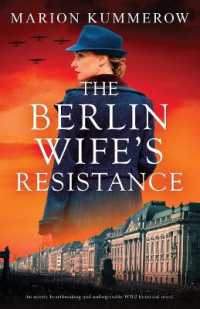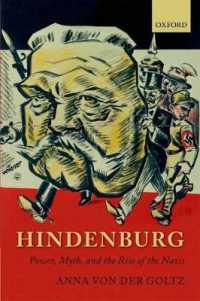- ホーム
- > 洋書
- > 英文書
- > History / World
基本説明
Vividly recovers unexplored aspects of popular history, and unpicks notions of the uncosy past, a place of pleasurable horror and sensationalism, which survived into the 1950s.
Full Description
In this original and widely researched book, Billie Melman explores the culture of history during the age of modernity. Her book is about the production of English pasts, the multiplicity of their representations and the myriad ways in which the English looked at history (sometimes in the most literal sense of 'looking') and made use of it in a social and material urban world, and in their imagination.
Covering the period between the Napoleonic Wars and the Coronation of 1953, Melman recoups the work of antiquarians, historians, novelists and publishers, wax modellers, cartoonists and illustrators, painters, playwrights and actors, reformers and educationalists, film stars and their fans, musicians and composers, opera-fans, and radio listeners. Avoiding a separation between 'high' and 'low' culture, Melman analyses nineteenth-century plebeian culture and twentieth-century mass-culture and their venues - like Madame Tussaud's Chamber of Horrors, panoramas, national monuments like the Tower of London, and films - as well as studying forms of 'minority' art - notably opera. She demonstrates how history was produced and how it circulated from texts, visual images, and sounds, to people and places and back to a variety of texts and images. While paying attention to individuals' making-do with culture, Melman considers constrictions of class, gender, the state, and the market-place on the consumption of history.
Focusing on two privileged pasts, the Tudor monarchy and the French Revolution, the latter seen as an English event and as the framework for narrating and comprehending history, Melman shows that during the nineteenth century, the most popular, longest-enduring, and most highly commercialized images of the past represented it not as cosy and secure, but rather as dangerous, disorderly, and violent. The past was also imagined as an urban place, rather than as rural. In Melman's account, City not green Country, is the centre of a popular version of the past whose central Images are the dungeon, the gallows, and the guillotine.
Contents
Part I - The French Connection: History and Culture After the Revolution ; 1. History as a Chamber of Horrors: the French Revolution in Madame Tussaud's ; 2. History as a Panorama: Spectacle and the People in Thomas Carlyle, The French Revolution ; 3. The Past as an Urban Place: Mid-Victorian Images of Revolution and Governance ; Part II - History as a Dungeon: Tudor Revivals and Urban Culture ; 4. Who Owns the Tower of London? The Production and Consumptions of a Historical Monument ; 5. Lady Jane: Torture, Gender and the Re-Invention of the Tudors ; Part III- Elizabethan Revivals, Consumption and Mass Democracy in the Modern Century ; 6. Buy Tudor: The Historical Film as a Mass Commodity ; 7. The Queen's Two Bodies; the King's Body: History, Monarchy and Stardom, 1933-53 ; Part IV- History and Glamour: The French Revolution and Modern Living 1900-1940 ; 8. The Revolution, Aristocrats and the People: The Returns of the Scarlet Pimpernel, 1900-1935 ; Part V- New Elizabethans? Postwar Culture and Failed Histories ; 9. Gloriana 1953: Failed Evocations of the Past ; Conclusion ; Bibliography







